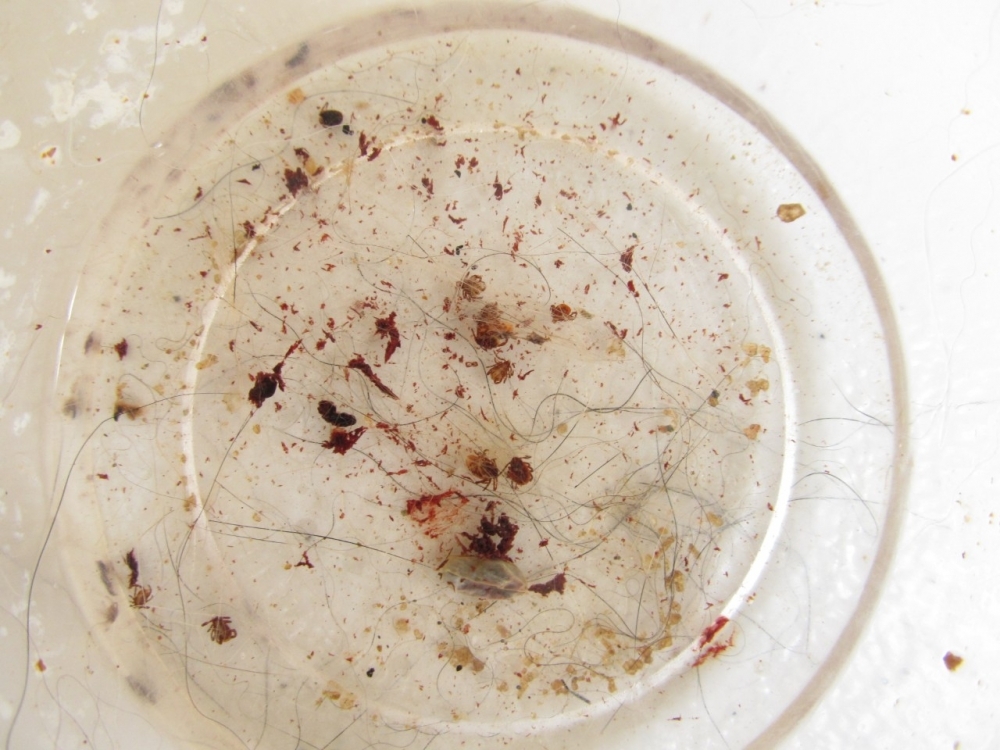

Experiments were conducted by scientists affiliated with the Center of Excellence in New Target Discovery, a research center supported by FAPESP, involving five animals with spontaneous skin tumors (photo: Daniel Souza / Wikimedia Commons)
Experiments were conducted by scientists affiliated with the Center of Excellence in New Target Discovery, a research center supported by FAPESP, involving five animals with spontaneous skin tumors.
Experiments were conducted by scientists affiliated with the Center of Excellence in New Target Discovery, a research center supported by FAPESP, involving five animals with spontaneous skin tumors.

Experiments were conducted by scientists affiliated with the Center of Excellence in New Target Discovery, a research center supported by FAPESP, involving five animals with spontaneous skin tumors (photo: Daniel Souza / Wikimedia Commons)
Agência FAPESP* – A protein derived from the saliva of the tick Amblyomma sculptum has been successfully used by researchers at the Butantan Institute in São Paulo, Brazil, to treat skin cancer (melanoma) in horses. The results of the study are described in the journal Scientific Reports.
The principal investigator for the project is Ana Marisa Chudzinski-Tavassi, who leads the Center of Excellence in New Target Discovery (CENTD), an Engineering Research Center (ERC) established at the Butantan Institute by FAPESP and GlaxoSmithKline.
CENTD’s mission is to discover and validate molecular targets to treat inflammatory diseases for the purpose of developing new drugs.
The protein is Amblyomin-X, which has been studied at the Butantan Institute for more than ten years and evidences significant antitumor potential in the laboratory and in vivo and has already been approved in preclinical toxicity testing.
The researchers used “omics” tools (genomics, transcriptomics, proteomics and metabolomics) to analyze the signaling pathways and proteins affected by the treatment of horse melanoma with Amblyomin-X.
Roger Chammas, a researcher at the São Paulo State Cancer Institute (ICESP), collaborated with CENTD scientists on the project.
Immune mechanisms
Equine melanomas are spontaneous tumors. Unlike cutaneous melanomas in humans, in horses, they are encapsulated and locally confined, rarely giving rise to metastasis. However, in both humans and horses, these tumors are potentially immunogenic, i.e., capable of producing an immune response, and can serve as a model for the investigation of the immune mechanisms involved in tumor regression induced by therapeutic molecules.
In the first phase of the study, spontaneous tumors in five horses were treated for 30 days with intratumoral injections of Amblyomin-X. The treatment took place at the Butantan Institute’s farm in Araçariguama, state of São Paulo. The animals were monitored throughout the period by means of clinical examinations, blood work, and biochemical laboratory tests.
The results were promising. Control tumors (not treated with the compound) maintained their shape and grew in size, whereas tumors treated with Amblyomin-X shrank and, in some cases, even reached remission up to two months after the treatment ended.
None of the five treated animals developed any adverse reactions. At the end of the treatment, the tumors were surgically removed for histopathological analysis. The researchers found no trace of tumoral characteristics.
The second phase of the study consisted of experiments in transcriptomics (analyzing messenger RNA expression) and interactomics (analyzing the interaction between tumor cell proteins and Amblyomin-X) to see how signaling pathways were modulated by the treatment and, especially, to obtain molecular confirmation of previous findings from in vitro and in vivo experiments conducted by Chudzinski-Tavassi and her team. The results published by the group between 2010 and 2017 suggested that the antitumor action of Amblyomin-X occurred via the modulation of the endoplasmic reticulum and mitochondrial stress and apoptotic and proteasomic pathways, among others.
The transcriptome study was expected to confirm activation of these pathways and show whether others were affected by the treatment. The researchers also deployed next-generation sequencing and analysis based on bioinformatics and systems biology to map the initial mechanisms of the response triggered by Amblyomin-X, which culminated in tumor regression.
Among the findings of the transcriptomic analysis was the discovery that the innate immune system’s rapid response (six hours after the injections) involved the modulation of four different pathways: TLR (toll-like receptor), RIG-I (viral invasion sensors), OAS (2’,5’- oligoadenylate synthetase and RNase L) and oncostatin-M (corresponding to the interleukin-6 family inflammation pathway). These findings described the first steps in the activation of a defense response that culminated in tumor regression, pointing to potential candidate targets for adjuvant therapies against tumors.
The article “Modulation of stress and immune response by Amblyomin-X results in tumor cell death in a horse melanoma model” by Flavio Lichtenstein, Asif Iqbal, Sonia Elisabete Alves de Lima Will, Rosemary Viola Bosch, Carlos DeOcesano-Pereira, Mauricio Barbugiani Goldfeder, Roger Chammas, Carlos Eduardo Madureira Trufen, Katia Luciano Pereira Morais, Jean Gabriel de Souza, Renato Jose Mendonça Natalino, Inacio Junqueira de Azevedo, Milton Yutaka Nishiyama Junior, Ursula Oliveira, Francisco Ivanio Arruda Alves, Jaqueline Mayara Araujo, Aline Ramos Maia Lobba and Ana Marisa Chudzinski-Tavassi can be read at: www.nature.com/articles/s41598-020-63275-2.
* With information from CENTD’s Diffusion Department.
Republish
The Agency FAPESP licenses news via Creative Commons (CC-BY-NC-ND) so that they can be republished free of charge and in a simple way by other digital or printed vehicles. Agência FAPESP must be credited as the source of the content being republished and the name of the reporter (if any) must be attributed. Using the HMTL button below allows compliance with these rules, detailed in Digital Republishing Policy FAPESP.





